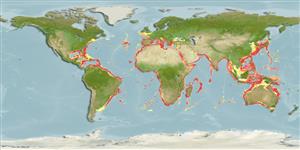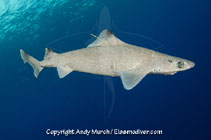Centrophorus granulosus (Bloch & Schneider, 1801)
Gulper shark
Beobachtung melden im Fish Watcher
| Native range | All suitable habitat | Point map | Year 2050 |

|
| This map was computer-generated and has not yet been reviewed. |
| Centrophorus granulosus AquaMaps Data sources: GBIF OBIS |
Hochladen Photos und videos
Pictures | Google BildCentrophorus granulosus
Picture by Murch, A.
Pictures | Google BildCentrophorus granulosus
Picture by Murch, A.
Senegal country information
Common names:
[No common name]
Occurrence: native
Salinity: marine
Abundance: | Ref:
Importance: | Ref:
Aquaculture: | Ref:
Regulations: | Ref:
Uses: no uses
Comments:
National Checklist:
Country Information: https://www.cia.gov/library/publications/resources/the-world-factbook/geos/sg.html
National Fisheries Authority: http://www.refer.sn/sngal_ct/eco/oeps/
Occurrences: Occurrences Point map
Main Ref: Compagno, L.J.V., 1984
National Database:
Occurrence: native
Salinity: marine
Abundance: | Ref:
Importance: | Ref:
Aquaculture: | Ref:
Regulations: | Ref:
Uses: no uses
Comments:
National Checklist:
Country Information: https://www.cia.gov/library/publications/resources/the-world-factbook/geos/sg.html
National Fisheries Authority: http://www.refer.sn/sngal_ct/eco/oeps/
Occurrences: Occurrences Point map
Main Ref: Compagno, L.J.V., 1984
National Database:
Common names from other countries
Klassifizierung / Names Namen | Synonyme | Catalog of Fishes(Gattung, Arten) | ITIS | CoL | WoRMS | Cloffa
Elasmobranchii (Haie und Rochen) (sharks and rays) > Squaliformes (Sleeper and dogfish sharks) > Centrophoridae (Gulper sharks)
Etymology: Centrophorus: centr[um] (L.), prickle or sharp point; phorus, from phoreus (Gr.), bearer or carrier, referring to grooved spines on dorsal fins (See ETYFish); granulosus: granum (L.), seed or grain; -osus, Latin suffix connoting fullness, referring to its granular brown skin (See ETYFish).
More on authors: Bloch & Schneider.
Etymology: Centrophorus: centr[um] (L.), prickle or sharp point; phorus, from phoreus (Gr.), bearer or carrier, referring to grooved spines on dorsal fins (See ETYFish); granulosus: granum (L.), seed or grain; -osus, Latin suffix connoting fullness, referring to its granular brown skin (See ETYFish).
More on authors: Bloch & Schneider.
Environment: milieu / climate zone / depth range / distribution range Ökologie
seewasser bathydemersal; tiefenbereich 98 - 1700 m (Ref. 94782), usually 200 - 600 m (Ref. 247). Deep-water; 58°N - 43°S, 98°W - 156°E
Verbreitung Länder | FAO Gebiete | Ecosystems | Vorkommen | Point map | Einführungen | Faunafri
Circumglobal: all ocean basins except in the Eastern Pacific and in the Mediterranean.
Length at first maturity / Size / Gewicht / Alter
Maturity: Lm ? range ? - ? cm
Max length : 124 cm TL Männchen/unbestimmt; (Ref. 94782); 165.0 cm TL (female)
Max length : 124 cm TL Männchen/unbestimmt; (Ref. 94782); 165.0 cm TL (female)
Kurzbeschreibung Bestimmungsschlüssel | Morphologie | Morphometrie
Wirbelzahl: 106 - 115. This species is distinguished by the following characters: large (>1.5 m maximum total length); body moderately robust; head moderately long (20.6-24.9% TL, 3.9-4.9 times in total length) and very robust; snout relatively short, horizontal preorbital length 4.8-8.1% TL, moderately rounded in dorsal view; first dorsal fin low and long, its height 4.4-6.5% TL, its soft length 11.0-16.6% TL), inner margin very long which is more than length from insertion of exposed spine to fin insertion; second dorsal fin large, similar in heigfree rear tip varying from slightly elongate in small individuals with free rear tip extension 0.9-2.2% TL in individuals < 70.0 cm TL, to moderately elongate in adults, 1.9-4.1% TL; lateral trunk denticles elevated on low, broad pedicel with strongly tricuspidate crowns in juveniles < 70.0 cm TL; denticles of large individuals low, not on pedicels, crown tear-drop shaped with one long posterior cusp; upper teeth of juveniles < 50.0 cm TL are strongly oblique; upper teeth of individuals > 70.0 cm TL with erect to slightly oblique cusps; lower teeth of all sizes are much larger than upper teeth, strongly oblique, blade-like; total vertebral centra 106-115; teeth 30-37/27-32; body uniformly brownish (sometimes greyish to greyish brown), slightly paler ventrally (Ref. 94782).
A common deepwater dogfish of the outer continental shelves and upper slopes, commonest below 200 m (Ref. 247); usually benthic and epibenthic at depths from 50-1440 m with most records from 200-600 m (Compagno, pers. comm. 07/07). Solitary (Ref. 26340). Adults feed mainly on bony fishes such as hake, epigonids, lanternfish, herring, smelts, cods, rattails, squid and crustaceans (Ref. 247, IUCN workshop 07/07). Males mature at about 105-118 cm TL (Ref. 94782). Ovoviviparous (Ref. 50449). This species is fished in Eastern Atlantic by bottom trawls, long lines, fixed bottom nets, hook and line and pelagic trawls; caught and discarded, or utilised from by-catch fisheries (IUCN discussion 07/07). Marketed smoked and dried salted for human consumption; also processed into fishmeal and a source of liver oil for squalene (Ref. 247).
Life cycle and mating behavior Geschlechtsreife | Fortpflanzung | Ablaichen | Eier | Fecundity | Larven
Ovoviviparous, embryos feed solely on yolk (Ref. 50449). Young are born from 30 to 42 cm or more (Ref. 247). Distinct pairing with embrace (Ref. 205).
Hauptreferenz
Upload your references | Referenzen | Koordinator : Compagno, Leonard J.V. | Partner
White, W.T., D.A. Ebert, G.J.P. Naylor, H.-H. Ho, P. Clerkin, A. Veríssimo and C.F. Cotton, 2013. Revision of the genus Centrophorus (Squaliformes: Centrophoridae): Part 1 -Redescription of Centrophorus granulosus (Bloch & Schneider), a senior synonym of C. acus and C. niaukang Teng. Zootaxa 3752(1):035-072. (Ref. 94782)
IUCN Rote Liste Status (Ref. 130435: Version 2024-1)
stark gefährdet (EN) (A2bd); Date assessed: 21 November 2019
Bedrohung für Menschen
Harmless
Nutzung durch Menschen
Fischereien: weniger kommerziell
FAO(Fischereien: production, Artbeschreibung; publication : search) | FishSource | Sea Around Us
Mehr Information
Population dynamics
Growth parameters
Max. ages / sizes
Length-weight rel.
Length-length rel.
Längenhäufigkeiten
Mass conversion
Rekrutierung
Dichte
Growth parameters
Max. ages / sizes
Length-weight rel.
Length-length rel.
Längenhäufigkeiten
Mass conversion
Rekrutierung
Dichte
Life cycle
Fortpflanzung
Geschlechtsreife
Fecundity
Ablaichen
Spawning aggregations
Eier
Eientwicklung
Larven
Larven Pop.Dyn.
Fortpflanzung
Geschlechtsreife
Fecundity
Ablaichen
Spawning aggregations
Eier
Eientwicklung
Larven
Larven Pop.Dyn.
Physiology
Body composition
Nutrients
Oxygen consumption
Swimming type
Swimming speed
Visual pigments
Fish sound
Diseases & Parasites
Toxicity (LC50s)
Body composition
Nutrients
Oxygen consumption
Swimming type
Swimming speed
Visual pigments
Fish sound
Diseases & Parasites
Toxicity (LC50s)
Genetics
Genetik
Heterozygosity
Vererbbarkeit
Genetik
Heterozygosity
Vererbbarkeit
Human related
Aquaculture systems
Aquakultur Profile
Zuchtlinien
Ciguatera cases
Stamps, coins, misc.
Aquaculture systems
Aquakultur Profile
Zuchtlinien
Ciguatera cases
Stamps, coins, misc.
Tools
E-book | Feldführer | Bestimmungsschlüssel | Längenhäufigkeits Tool | Lebensdaten Tool | Punkt Karte | Classification Tree
| Catch-MSY |
Zusatzinformationen
Download XML
Zusammenfassung | Point data | Namen | Photos
Internet Quellen
Aquatic Commons | BHL | Cloffa | BOLDSystems | Websites from users | FishWatcher Einträge suchen | CISTI | Catalog of Fishes(Gattung, Arten) | DiscoverLife | ECOTOX | Faunafri | Fishtrace | GenBank(Genom, nucleotide) | GloBI | GOBASE | | Google Books | Google Scholar | Google | IGFA World Record | MitoFish | Nationale Datenbanken | Otolith Atlas of Taiwan Fishes | PubMed | Reef Life Survey | Scirus | SeaLifeBase | Tree of Life | Wikipedia(Gehe zu, Suchen) | World Records Freshwater Fishing | Zoological Record
Estimates based on models
Preferred temperature (Ref. 115969): 7.7 - 17.3, mean 11.4 (based on 1031 cells).
Phylogenetic diversity index (Ref. 82804): PD50 = 0.5001 [Uniqueness, from 0.5 = low to 2.0 = high].
Bayesian length-weight: a=0.00200 (0.00159 - 0.00251), b=3.21 (3.14 - 3.28), in cm Total Length, based on LWR estimates for this species (Ref. 93245).
Trophic level (Ref. 69278): 4.1 ±0.4 se; based on diet studies.
Widerstandsfähigkeit (Ref. 120179): niedrig, Verdopplung der Population dauert 4,5 - 14 Jahre. (Fec assumed to be <100).
Fishing Vulnerability (Ref. 59153): High to very high vulnerability (70 of 100).
Climate Vulnerability (Ref. 125649): Moderate vulnerability (43 of 100).




